What is Snopes and How Can It Be Used to Teach? Tips & Tricks
Snopes is a fact-checking website that can help students in education to better navigate online media

Snopes is a fact-checking website that is famous for debunking common myths. But it is also a useful source for finding truth on the internet. As such it can be used by teachers and students in class.
Launched in 1994, this was originally an urban folklore website and has grown over the years into a go-to online resource for facts. During the COVID-19 pandemic, for example, the site had more than 237 fact-checking articles related this the issue of coronavirus truths and lies.
Snopes can serve as a useful resource for teachers to fact check but, perhaps more crucially, it is a useful tool to help students learn to question and find answers about less-than-clear issues. Taught correctly, this site can help students become better fact finders so they are able to navigate the murky online waters of the internet more adeptly on their own.
What is Snopes?
Snopes was originally a website setup and run by a husband and wife couple. It has since grown and developed into a platform for truth, debunking common misconceptions with facts.

From guides on how to be smart using social media to articles explaining how to avoid scams on Cyber Monday, right through to clarifying the Cookie Monster's real name -- the subject matter is hugely varied.
The site is not built with kids in mind, so educators and parents be warned, this is not for younger audiences. Even with older children, it should be a supervised experience. The site itself says: "Urban legends are expressions of adult fears and concerns and, as such, often convey those messages via stories that are unsuitable for children."
All that said, the content has varied a lot since that disclaimer went up several years back and there is now a lot of useful child-safe content available too.
Tools and ideas to transform education. Sign up below.
How does Snopes work?
Snopes takes a common issue or story and clarifies the truth behind that by doing the research and then laying out the facts clearly in a way that is easy to read and check.

In a similar way to Wikipedia, Snopes articles are filled with plenty of source links so you can not only read what is being laid out but also fact check as you go. This in itself is a valuable way to teach kids that reading isn't believing when online and looking for source links -- as well as checking those -- are important parts of consuming media.
It's possible to browse by various categories including Latest, Top, Fact Checks, Collections, News, Archives, and a Randomizer. The stories themselves are laid out fairly uniformly, making it easy to navigate quickly.
What are the best Snopes features?
Snopes usefully lays out out a "True" logo with a tick, or "False" logo with a cross right at the start of the article, making it clear which way the argument is going to be made from the outset. This helps with clarity for younger readers and models well the argument for one side over another.

Usefully, each article provides the history of the claim before diving into the facts, a bit like bringing you up to speed. So even if students haven't heard of an issue, the site provides the background before arguing for or against the truth of it.
All source links are helpfully included in-line so you can check as you read, making sure everything is properly backed up by facts. You then also have a references guide at the bottom of the article, clearly laying out all sources.
An updates section is provided at the end of each article, making it clear if something has come to light chronologically after the piece itself was published.
How much does Snopes cost?
Snopes is a free resource made available to all. It does have advertisements on the website, which help to fund the staff and cover operational costs.
Personal data is not required as this site can be accessed immediately without inputting anything to get everything that is available to read.
Snopes best tips and tricks
Show and tell
Have students bring a story each week, explaining what has been debunked, how, and why you found that interesting in relation to the class.
Create your own
Make a fun story about the class and its students, including links to sources to show how these articles are written.
Build a Snope
Have students create their own Snopes-style article, taking a story and either debunking it with facts or simply correcting parts where they can find sources for other viewpoints.
Luke Edwards is a freelance writer and editor with more than two decades of experience covering tech, science, and health. He writes for many publications covering health tech, software and apps, digital teaching tools, VPNs, TV, audio, smart home, antivirus, broadband, smartphones, cars and much more.
